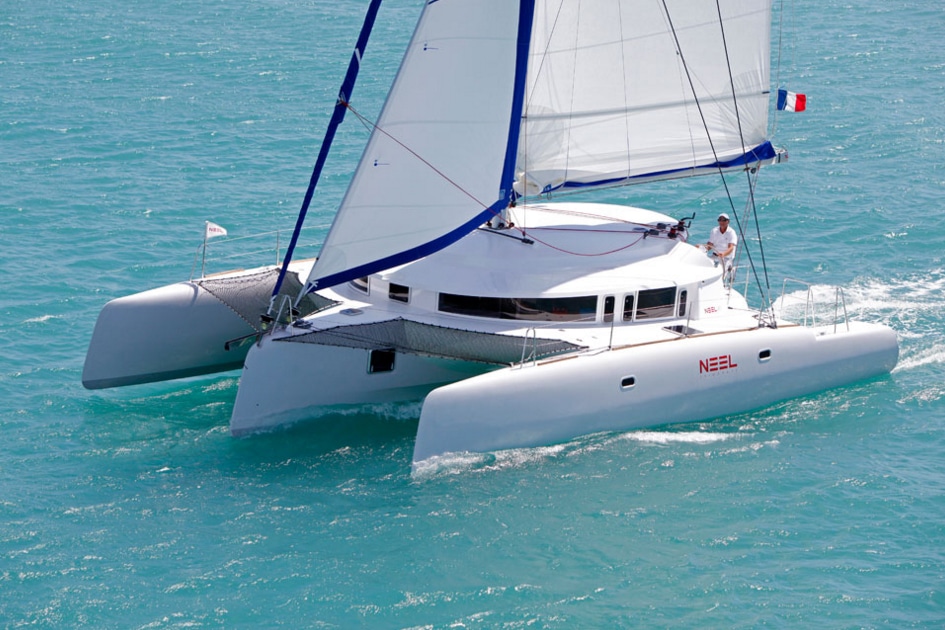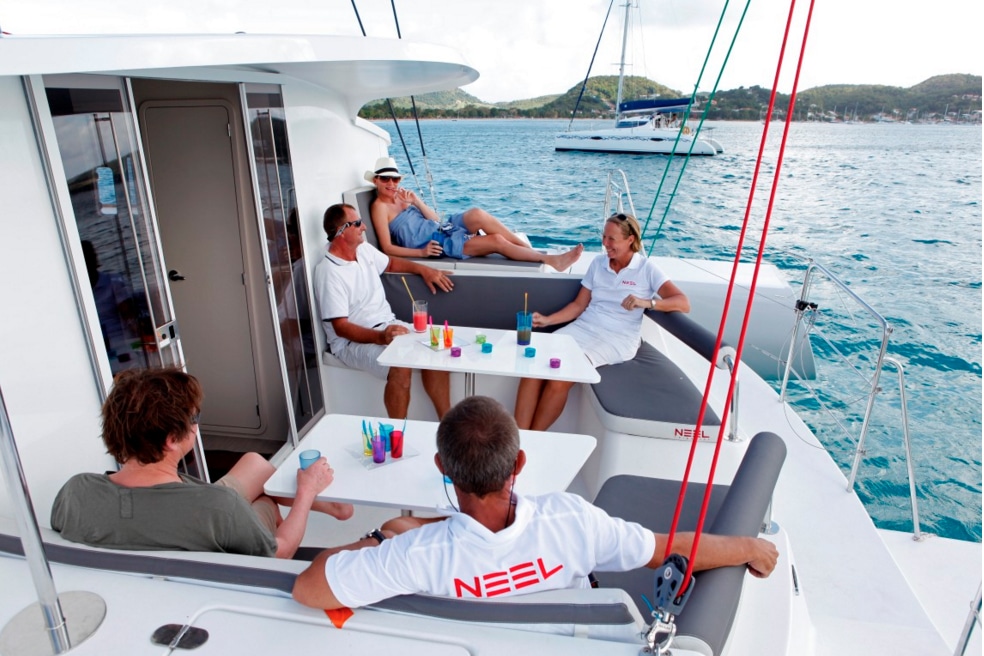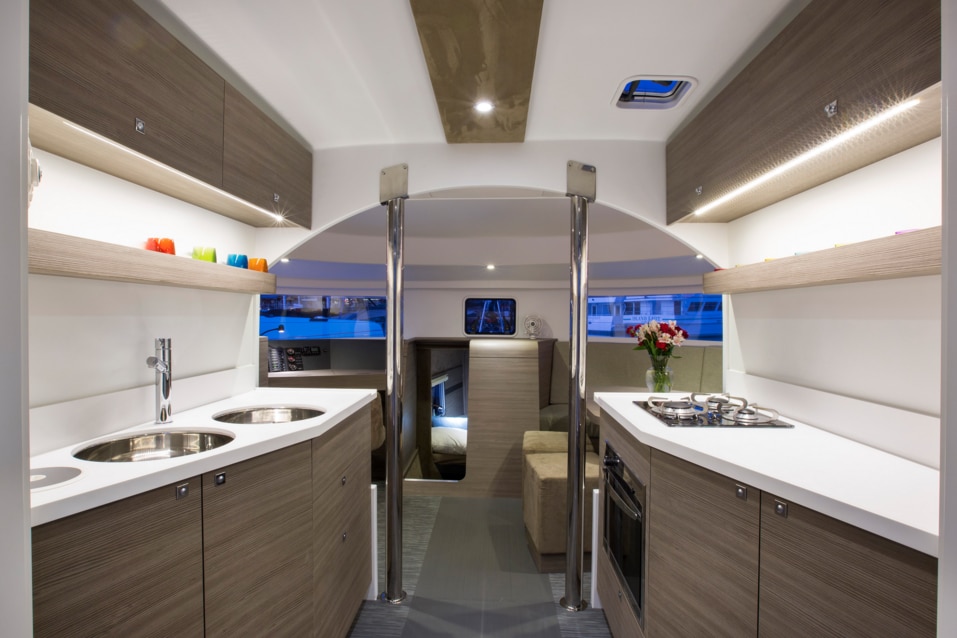
There are two salient points about French sailor, entrepreneur, and offshore racer Eric Bruneel that anyone interested in his striking new Neel 45 cruising trimaran should know. (And honestly, if you call yourself a sailor, this is a boat that should seriously pique your curiosity.) First, in a previous life, Bruneel was the grand fromage (“big cheese”) at Fountaine Pajot catamarans, where he oversaw the construction of hundreds and hundreds of boats, so he knows multihulls inside and out. And second, his personal boat was a sleek and spartan 50-foot trimaran aboard which he won singlehanded transatlantic races, so he has a particular affinity for and understanding of the potential of vessels with three hulls.
When Bruneel struck out on his own, he combined his experience with his passion to create what’s easily the most radical, refined, and intriguing production multihull to come down the pike in quite some time. At least that was the unanimous consensus of our 2013 Boat of the Year judging panel, for after sailing the Neel 45 off Annapolis, Maryland, last fall, they concluded that Bruneel’s fascinating and flashy tri was the real deal, and they named it the Most Innovative vessel in the fleet.
“This is a boat I think will really appeal to the multihull enthusiast who wants something that’s pretty easy to sail but offers high performance,” said judge Ed Sherman. “It’s just a fun boat. I certainly enjoyed it in every way.”

So what, exactly, did the panel find so alluring?
Let’s start with the sailing, for on the Neel 45, everything works backward from there. It’s the central point of the entire exercise. And boy, does this boat sail. Bruneel calls it “a 10-knot boat,” and he reported that on the transatlantic delivery from France, it averaged 230 nautical miles a day, which puts it in an exclusive neighborhood. During our test sail, conducted in a 16- to 18-knot northerly—we experimented with multiple sail plans by furling and unfurling the self-tacking jib and code zero-type gennaker and reefing and unreefing the big, square-topped mainsail—we actually recorded better numbers. Upwind, we saw 11.2 knots, and reaching, we did better than 12. Hee-haw!
But you really need to operate the boat to understand why it was so neat. Everything was so simple. The wheel was light as a feather. All the sail controls were readily at hand (with the exception of the main halyard, which is on the mast). When the windward ama, or hull, lifted clear of the water and the boat effectively sailed on two hulls, with limited wetted surface, the sensation was surreal; it felt like flying. There were tons of nifty features, including a mainsheet that can be quickly anchored in different locations thanks to multiple padeyes, which really opens up trimming options. Heck, the emergency tiller provided a lighter helm than the standard steering on many of the other boats in the 2013 contest.
Down below, there’s plenty to celebrate as well, beginning with the ample 6-foot-8-inch headroom. When you enter from the cockpit, there’s a long corridor that includes the straight-line galley, with access to a pair of staterooms, one each to port and starboard, featuring outward-facing double berths. Forward, there’s a wonderful nav station opposing the central dining space with a wraparound settee; a third double cabin with a big V-berth is in the bow. It’s an extremely effective use of unusual space.
The centerpiece of the interior layout is the deep and commodious engine room in the middle of the boat, which is accessed by a long ladder through a wide hatch. All major systems, including steering and other machinery, can be easily inspected and serviced. Unlike catamarans, there’s only a single engine, which reduces cost. A bow thruster addresses the lost maneuverability you’d find on a similarly beamy catamaran with a pair of power plants and props.

That leaves us with the aesthetics, which, of course, are a matter of personal taste. I really enjoyed the boat’s contemporary looks, but I concede they won’t be everyone’s cup of tea. Judge Tim Murphy reckoned the cabin top resembled “a sort of Starship Enterprise shape.” But fellow panelist Alvah Simon had an
interesting take: “The ergonomics were quite strange at first. I wasn’t sure I understood them or even liked them. There was a curved coaming, and the aft decks kind of curved up and around. But as we began moving around on the boat while under way, I got it. They work. It’s as simple as that: They worked.”
Bruneel has a simple marketing plan going forward: He wants to build five boats this year, 10 the next, 20 in Year Three, and then introduce a new model. We wish him the best. Let’s put it this way: If there was a category for the coolest boat of the year, the Neel 45 would be the runaway winner.
To see more photos of the Neel 45 click here








